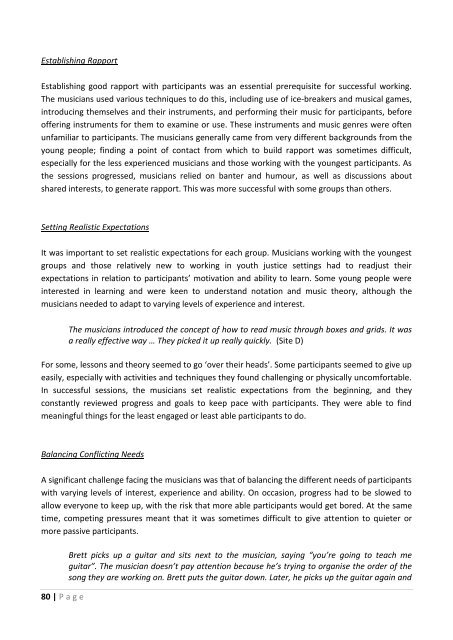De Viggiani, N., Daykin, N., Moriarty, Y. and Pilkington, P. and ...
De Viggiani, N., Daykin, N., Moriarty, Y. and Pilkington, P. and ...
De Viggiani, N., Daykin, N., Moriarty, Y. and Pilkington, P. and ...
You also want an ePaper? Increase the reach of your titles
YUMPU automatically turns print PDFs into web optimized ePapers that Google loves.
Establishing Rapport<br />
Establishing good rapport with participants was an essential prerequisite for successful working.<br />
The musicians used various techniques to do this, including use of ice-breakers <strong>and</strong> musical games,<br />
introducing themselves <strong>and</strong> their instruments, <strong>and</strong> performing their music for participants, before<br />
offering instruments for them to examine or use. These instruments <strong>and</strong> music genres were often<br />
unfamiliar to participants. The musicians generally came from very different backgrounds from the<br />
young people; finding a point of contact from which to build rapport was sometimes difficult,<br />
especially for the less experienced musicians <strong>and</strong> those working with the youngest participants. As<br />
the sessions progressed, musicians relied on banter <strong>and</strong> humour, as well as discussions about<br />
shared interests, to generate rapport. This was more successful with some groups than others.<br />
Setting Realistic Expectations<br />
It was important to set realistic expectations for each group. Musicians working with the youngest<br />
groups <strong>and</strong> those relatively new to working in youth justice settings had to readjust their<br />
expectations in relation to participants’ motivation <strong>and</strong> ability to learn. Some young people were<br />
interested in learning <strong>and</strong> were keen to underst<strong>and</strong> notation <strong>and</strong> music theory, although the<br />
musicians needed to adapt to varying levels of experience <strong>and</strong> interest.<br />
The musicians introduced the concept of how to read music through boxes <strong>and</strong> grids. It was<br />
a really effective way … They picked it up really quickly. (Site D)<br />
For some, lessons <strong>and</strong> theory seemed to go ‘over their heads’. Some participants seemed to give up<br />
easily, especially with activities <strong>and</strong> techniques they found challenging or physically uncomfortable.<br />
In successful sessions, the musicians set realistic expectations from the beginning, <strong>and</strong> they<br />
constantly reviewed progress <strong>and</strong> goals to keep pace with participants. They were able to find<br />
meaningful things for the least engaged or least able participants to do.<br />
Balancing Conflicting Needs<br />
A significant challenge facing the musicians was that of balancing the different needs of participants<br />
with varying levels of interest, experience <strong>and</strong> ability. On occasion, progress had to be slowed to<br />
allow everyone to keep up, with the risk that more able participants would get bored. At the same<br />
time, competing pressures meant that it was sometimes difficult to give attention to quieter or<br />
more passive participants.<br />
80 | P a g e<br />
Brett picks up a guitar <strong>and</strong> sits next to the musician, saying “you’re going to teach me<br />
guitar”. The musician doesn’t pay attention because he’s trying to organise the order of the<br />
song they are working on. Brett puts the guitar down. Later, he picks up the guitar again <strong>and</strong>
















